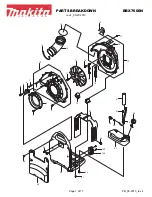
Agile 4250 O & M Manual Iss-01
11.
Maintenance Schedule
If the PVC top sheet is punctured take the following action:
• Puncture less than 10mm in any direction: Mark with an indelible marker, record the date and monitor on
a monthly basis.
• Puncture between 11-30mmin any direction: Mark with an indelible marker, record the date and monitor
on a weekly basis.
• Punctures greater than 31mm in any direction: Prompt repair is required, Mark with an indelible marker,
record the date and monitor on a daily basis.
If the PVC top sheet has been punctured and begins to tear take the following action:
Tears on or near the gable end pocket of any size require immediate attention. Tears can be rectified with
a patch repair welded on-site (using specialist fabric welding equipment) or when necessary a full sheet
replacement.
Tears in the body of the main roof sheet:
• Tears less than 100mm in any direction: Prompt repair is required, photograph the area, contact your
supplier, mark with an indelible marker and monitor on a daily basis.
• Tears between 100-700mm in any direction: Prompt repair is required, photograph the area, contact your
supplier, mark with an indelible marker and monitor on a twice daily basis. It is recommended to tension
ratchet straps over the building 500mm on either side of the tear to prevent the damaged area from
increasing.
• Tears greater than 701mm Prompt repair is required, contact your supplier, mark with an indelible marker
and monitor on a twice daily basis. It is recommended to tension ratchet straps over the building 500mm
on either side of the tear to prevent the damaged area from increasing. A new roof sheet is likely to be
required.
Damaged sheets - IMPORTANT NOTE:
If the sheet is significantly damaged and high winds are forecast it may be necessary to remove the damaged
sheet.
It is the building and site owners responsibility to assess and manage the risk to prevent the sheet from causing
damage to the structure or any adjacent structures or equipment. In the worst case, a sheet with significant
damage can flap uncontrollably in high winds and act as a sail causing damage to the structural framework - if
the sheet becomes separated from the building in high winds it is likely to travel in the air and risks damaging
neighbouring sites. The judgement to remove the sheet is the responsibility of the owner.
DO NOT ATTEMPT TO REMOVE THE SHEET IN HIGH WINDS.
For emergencies, general maintenance and assistance contact
McGregor by phone or email.
01962 772368



































